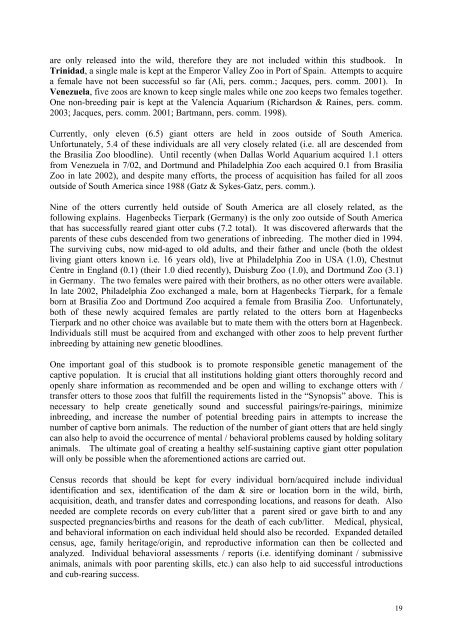International Giant Otter Studbook Husbandry and Management
International Giant Otter Studbook Husbandry and Management
International Giant Otter Studbook Husbandry and Management
You also want an ePaper? Increase the reach of your titles
YUMPU automatically turns print PDFs into web optimized ePapers that Google loves.
are only released into the wild, therefore they are not included within this studbook. In<br />
Trinidad, a single male is kept at the Emperor Valley Zoo in Port of Spain. Attempts to acquire<br />
a female have not been successful so far (Ali, pers. comm.; Jacques, pers. comm. 2001). In<br />
Venezuela, five zoos are known to keep single males while one zoo keeps two females together.<br />
One non-breeding pair is kept at the Valencia Aquarium (Richardson & Raines, pers. comm.<br />
2003; Jacques, pers. comm. 2001; Bartmann, pers. comm. 1998).<br />
Currently, only eleven (6.5) giant otters are held in zoos outside of South America.<br />
Unfortunately, 5.4 of these individuals are all very closely related (i.e. all are descended from<br />
the Brasilia Zoo bloodline). Until recently (when Dallas World Aquarium acquired 1.1 otters<br />
from Venezuela in 7/02, <strong>and</strong> Dortmund <strong>and</strong> Philadelphia Zoo each acquired 0.1 from Brasilia<br />
Zoo in late 2002), <strong>and</strong> despite many efforts, the process of acquisition has failed for all zoos<br />
outside of South America since 1988 (Gatz & Sykes-Gatz, pers. comm.).<br />
Nine of the otters currently held outside of South America are all closely related, as the<br />
following explains. Hagenbecks Tierpark (Germany) is the only zoo outside of South America<br />
that has successfully reared giant otter cubs (7.2 total). It was discovered afterwards that the<br />
parents of these cubs descended from two generations of inbreeding. The mother died in 1994.<br />
The surviving cubs, now mid-aged to old adults, <strong>and</strong> their father <strong>and</strong> uncle (both the oldest<br />
living giant otters known i.e. 16 years old), live at Philadelphia Zoo in USA (1.0), Chestnut<br />
Centre in Engl<strong>and</strong> (0.1) (their 1.0 died recently), Duisburg Zoo (1.0), <strong>and</strong> Dortmund Zoo (3.1)<br />
in Germany. The two females were paired with their brothers, as no other otters were available.<br />
In late 2002, Philadelphia Zoo exchanged a male, born at Hagenbecks Tierpark, for a female<br />
born at Brasilia Zoo <strong>and</strong> Dortmund Zoo acquired a female from Brasilia Zoo. Unfortunately,<br />
both of these newly acquired females are partly related to the otters born at Hagenbecks<br />
Tierpark <strong>and</strong> no other choice was available but to mate them with the otters born at Hagenbeck.<br />
Individuals still must be acquired from <strong>and</strong> exchanged with other zoos to help prevent further<br />
inbreeding by attaining new genetic bloodlines.<br />
One important goal of this studbook is to promote responsible genetic management of the<br />
captive population. It is crucial that all institutions holding giant otters thoroughly record <strong>and</strong><br />
openly share information as recommended <strong>and</strong> be open <strong>and</strong> willing to exchange otters with /<br />
transfer otters to those zoos that fulfill the requirements listed in the “Synopsis” above. This is<br />
necessary to help create genetically sound <strong>and</strong> successful pairings/re-pairings, minimize<br />
inbreeding, <strong>and</strong> increase the number of potential breeding pairs in attempts to increase the<br />
number of captive born animals. The reduction of the number of giant otters that are held singly<br />
can also help to avoid the occurrence of mental / behavioral problems caused by holding solitary<br />
animals. The ultimate goal of creating a healthy self-sustaining captive giant otter population<br />
will only be possible when the aforementioned actions are carried out.<br />
Census records that should be kept for every individual born/acquired include individual<br />
identification <strong>and</strong> sex, identification of the dam & sire or location born in the wild, birth,<br />
acquisition, death, <strong>and</strong> transfer dates <strong>and</strong> corresponding locations, <strong>and</strong> reasons for death. Also<br />
needed are complete records on every cub/litter that a parent sired or gave birth to <strong>and</strong> any<br />
suspected pregnancies/births <strong>and</strong> reasons for the death of each cub/litter. Medical, physical,<br />
<strong>and</strong> behavioral information on each individual held should also be recorded. Exp<strong>and</strong>ed detailed<br />
census, age, family heritage/origin, <strong>and</strong> reproductive information can then be collected <strong>and</strong><br />
analyzed. Individual behavioral assessments / reports (i.e. identifying dominant / submissive<br />
animals, animals with poor parenting skills, etc.) can also help to aid successful introductions<br />
<strong>and</strong> cub-rearing success.<br />
19

















